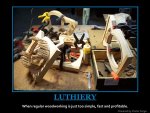nate_dennis
Well-known member
I know that this question will be somewhat subjective, and I don't even know if it's a realistic scenario. But here we go . . . .
If we used a purely acoustic guitar with no cutaway as a baseline; would the same guitar with electronics installed sound different? What about if the same model was made with a cutaway. Would either of these affect the tone assuming that that the "modifications" were made at the manufactureres level? I hope this makes sense; I'm just trying to learn as much as possible about guitars. Thank you for your time.
-Nate
If we used a purely acoustic guitar with no cutaway as a baseline; would the same guitar with electronics installed sound different? What about if the same model was made with a cutaway. Would either of these affect the tone assuming that that the "modifications" were made at the manufactureres level? I hope this makes sense; I'm just trying to learn as much as possible about guitars. Thank you for your time.
-Nate




